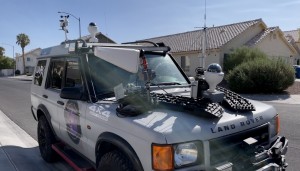Las Vegas, Nevada Apr 30, 2022 (Issuewire.com) - UAPx (Unidentified Aerial Phenomena Expeditions Group, LLC.) potentially discovered a previously unknown, entirely unclassified, scientifically uncategorized atmospheric anomaly while on an expedition subject of an upcoming documentary film, A Tear in The Sky, by Omnium Media. The film is scheduled for release in the United States and Europe on May 3, 2022, and will initially be available on Amazon Prime Video, AppleTV, Google Play, and VUDU.
In July 2021, UAPx team members conducted sensor readings as part of an expedition to Catalina Channel, a historical UAP hotspot off the coast of California that falls in close proximity to the location of the well-documented USS Nimitz "Tic-tac" incident. As Navy veterans, UAPx co-founders Kevin Day, Gary Voorhis, and Jason Turner served aboard the USS Princeton during the encounters. In efforts to come closer to an understanding of their experience, they established UAPx to investigate the phenomenon, starting with an initial five-day research expedition identifying, recording, and documenting potential anomalous activity in the same region.
In a post-expedition review of the collected sensor data, USAF veteran and UAPx operations specialist Jeremy McGowan discovered the existence of a distinct anomaly captured in the Catalina channel by the UFODAP (UFO Data Acquisition Project), a multi-sensor data acquisition unit created by Ron Olch. Multiple independent sensors registered an atmospheric anomaly in conjunction with increased high-energy particles above the statistical norm.
"Shortly after we returned from the mission," McGowan said, "Matthew put together a data tracking spreadsheet with a summary of the output from the MIT Cosmic Watch."
Dr. Matthew Szydagis, UAPx scientist and Associate Professor of Physics at UAlbany SUNY, used a Cosmic Watch, a cosmic ray detector, to acquire critical environmental readings from the mission. Anomalous radiation spikes from the Cosmic Watch were cross-referenced with FLIR and UFODAP visible spectrum video.
All videos were checked for correlations with radar, infrasound, seismograph, satellite, compiled SIGINT (Signals Intelligence) and MASINT (Measurement and Signature Intelligence) data, including a custom-built QRNG (Quantum Random Number Generator), designed and deployed by UAPx quantum technologist and NASA-trained Commercial Astronaut Christopher Altman, to function as a baseline metric in comparison to any anomalous environmental readings. The device was installed by Mr. David Mason under Altman's guidance and instruction.
In regards to the discovery of the anomaly, McGowan stated:
"The idea of the spreadsheet was to list all the events of significance to begin correlating those events with potential video captures in FLIR and the UFODAP/OSIRIS cameras. On the first day of work, I found the atmospheric anomaly event on the OSIRIS2 camera system, a sister unit to the sensors and cameras on the O.S.I.R.I.S. (the Off-road Scientific Investigation & Response Informatics System). This was only 12 frames of video and would have likely been overlooked by most; however, I was watching each video frame-by-frame. Matthew's spreadsheet saved countless hours of work, as it enabled me to cut down on the time of the videos instead of going through 22,000 different UFODAP/OSIRIS files. After correlating the timestamp of the most significant radiological event from Matthew's data to that of the captured video of the atmospheric event, I knew we had something but had no idea it would be the main event of our expedition. I sat on it for a full day before I told the team, as I had no idea how to approach them with this. It could have been either a giant nothing-burger—or one of the most significant discoveries in modern history. We still do not know exactly what this was and will likely be studying it for a long time to come."
When Dr. Szydagis' Cosmic Watch and the local Doppler weather radar data secured by colleague Dr. Kevin Knuth, UAPx scientist and Associate Professor in Physics at UAlbany SUNY, were pulled together, it became evident there was a highly energetic, anomalous physical and atmospheric event.
"The Doppler weather radar revealed a significant degree of turbulence in the approximate vicinity of the anomaly and the apparent presence of radar-reflecting metallic objects," stated Knuth. According to Szydagis, "I couldn't believe that Jeremy struck paydirt immediately, after starting out by looking only at the first (highest-energy) radiation anomaly on my list, a ~43 MeV per centimeter interaction, to check for correlations in the UFODAP's camera system. Such an event should only have occurred with a probability of less than 1 in 100,000 per week, yet we collected fewer than 100,000 events during our expedition. By itself, this could easily still be a statistical fluke, but the correlation with an anomaly caught on camera is what makes this so interesting."
UAPx scientists Kevin Knuth, Matthew Szydagis, and Christopher Altman will present key findings from the expedition at the upcoming SCU Anomalous Aerospace Phenomena Conference from June 3-5, 2022, in Huntsville, Alabama.
The documentary film covering the expedition captured and portrayed the experiences, excitement, and enthusiasm for the team's efforts in studying UAPs. However, the scientific journey has just begun. UAPx embarked on the painstaking task of carefully identifying events out of hundreds of hours of imagery that appear anomalous and ruling out large numbers of prosaic and unusual hypotheses to determine what can be learned from the recordings. For this reason, conclusive statements about observations cannot yet be made. UAPx research is expected to take several months to years. The company is enlisting several scientists from around the world with expertise in a wide variety of fields. UAPx is pulling in experts in astrophysics, meteorology, atmospheric physics, and oceanography. Together the company is working to collect additional data from other sources, including satellite imagery, meteorological radar data, imagery and records from permanent observation stations, as well as other scientific missions, such as the Laser Interferometer Gravitational-Wave Observatory (LIGO) and the Energetic and Relativistic Nuclei and Electrons Experiment (ERNE). As explicitly stated in their Mission Statement, they will begin making their data and recordings available to other scientists and the public as they progress in studies, presenting the results to the scientific community and publishing them in the scientific literature.
In conjunction with the SCU (Scientific Coalition for UAP Studies) over 600 hours of FLIR recordings are currently under review by the UAPx science team, which is hard at work to analyze the data for forthcoming publications in peer-reviewed academic journals—but the findings explored thus far constitute only a tiny fraction of the data. UAPx urgently needs field-specific volunteers who wish to contribute to the analysis of this one-of-a-kind dataset and who can commit significant time and attention to help realize the project's objectives.
Gary Voorhis, President of UAPx, stated: "This is just the beginning. UAPx wants to express gratitude to Ms. Caroline Cory for allowing us to put our two-year plan into motion and for creating a very entertaining film. We want to thank David Mason for providing FLIR cameras and other equipment to test. We'd also like to thank Sr. Chief Kevin Day, co-founder of UAPx. His keen insights, commitment to science, and determination to pursue the truth serve as sources of inspiration. Finally, we want to express our gratitude to David Altman and Michael W. Hall for their tireless efforts in collecting video data while on Catalina Island. UAPx is committed to the absolute highest standards of academic inquiry and review. We are wholeheartedly dedicated and determined to bring the state of knowledge closer to a scientific understanding of Unidentified Aerial Phenomena."
To donate funds or learn more about UAPx, its research, and its vision for the future, visit its website for details at http://www.UAPx.space
For media interviews with UAPx, contact:
Mr. Alex Garcia / alex@garrotero.com
Media Contact
UAPx j.mcgowan@uapexpedition.org http://www.uapexpedition.org










